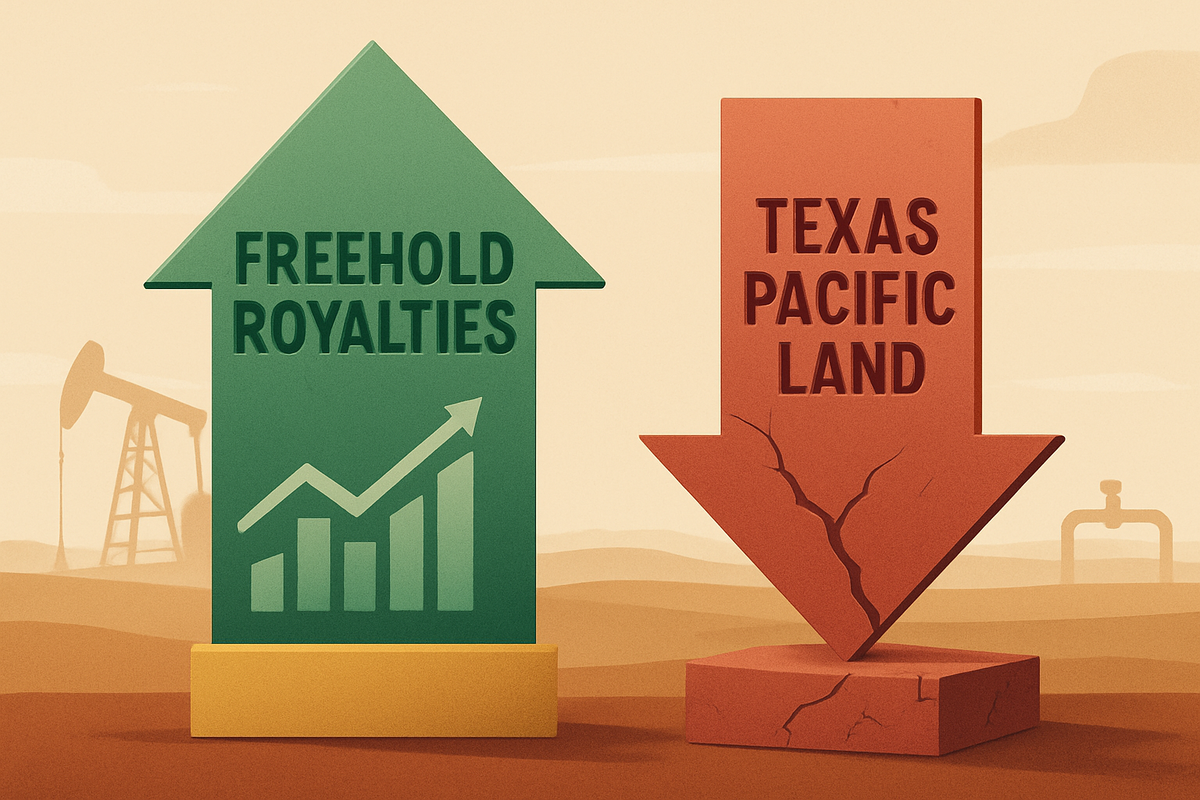Freehold Royalties Dominates as Texas Pacific Land Faces Valuation Reality Check in Shifting Commodity Landscape

Calgary, AB & Dallas, TX – November 28, 2025 – In a significant divergence within the commodity land sector, Freehold Royalties Ltd. (TSX:FRU:CA) has markedly outperformed Texas Pacific Land Corporation (NYSE: TPL) over the past year, signaling a potential recalibration of investor sentiment and a re-evaluation of long-term prospects for companies in this niche. While Texas Pacific Land experienced a parabolic surge in late 2024, its subsequent decline has led to a 35% loss for investors over the last year, starkly contrasting with Freehold Royalties' robust performance. This shift highlights the critical importance of valuation, operational strategy, and commodity exposure in navigating the complex and often volatile energy and land markets.
The underperformance of Texas Pacific Land, despite its historically strong position in the prolific Permian Basin, suggests that its previous premium valuation may have been unsustainable. Conversely, Freehold Royalties' more attractive valuation, coupled with strong operational execution and a compelling dividend yield, has resonated with investors seeking stability and consistent returns. This market dynamic raises questions about the long-term outlook for Texas Pacific Land and underscores the evolving factors driving success in the commodity land sector as 2025 draws to a close.
A Tale of Two Royalty Models: FRU's Strategic Edge and TPL's Valuation Correction
The contrasting fortunes of Freehold Royalties and Texas Pacific Land can be largely attributed to their distinct business models, strategic focuses, and the market's re-assessment of their respective valuations. Freehold Royalties, primarily a passive royalty company in the oil and gas sector, boasts a diversified portfolio spanning key Canadian basins and an expanding presence in premium U.S. regions like the Permian, Eagle Ford, Haynesville, and Bakken. Its model allows it to generate revenue from a percentage of oil and gas production and lease income without incurring the substantial capital costs associated with drilling or operating wells. This insulation from direct operational risks translates into higher profitability and a consistent return of value to shareholders through a hefty dividend, which was around 7-8.8% in 2025. Freehold's Q1 2025 results, showing a 23% year-over-year revenue surge driven by record U.S. production and higher liquids content, exemplify its operational efficiency and strategic asset management.
Texas Pacific Land, one of the largest landowners in Texas with approximately 868,000 to 880,000 acres predominantly in the Permian Basin, monetizes its land and mineral interests through a diversified approach. Its revenue streams include perpetual royalty interests on oil and gas production, water services and infrastructure through its subsidiary Texas Pacific Water Resources (TPWR), surface land leasing, and increasingly, renewable energy development. While TPL's business model is characterized by high-margin activities and minimal operational costs, yielding impressive adjusted EBITDA margins (around 86% in 2023) and a debt-free balance sheet, its recent performance has been hampered by a significant valuation correction.
The period leading up to late 2025 saw Texas Pacific Land experience a "parabolic" rise in late 2024, pushing its valuation to what many analysts considered unsustainable levels, with a forward price/earnings (P/E) ratio of 52.50. By July 2025, TPL was still priced at approximately 30 times sales and two times its estimated net asset value (NAV). The subsequent decline in TPL's stock is largely viewed as a "normalization of sentiment" and the "bursting of a bubble," as investors reassessed its growth trajectory against its elevated price. Compounding this, Texas Pacific Land missed analyst estimates by a significant margin in Q3 2025, further contributing to its underperformance. This contrasts sharply with Freehold Royalties, which maintained an "attractive" valuation, making it a more appealing investment in the current market environment.
The commodity land sector in late 2025 presents a mixed outlook. While some analysts anticipate a bottoming out of the global economy in Q4 2025, potentially boosting demand for industrial and agricultural commodities in 2026, the oil market in 2025 has been characterized by a potential supply glut, with significant new production coming online from the U.S., Canada, Guyana, and Brazil. The International Energy Agency (IEA) predicted a well-supplied market, which could lead to lower oil prices, although long-term underinvestment in oil and gas capital expenditure could create medium-term supply limitations. Natural gas, however, is projected to have a "boom year" in 2025, driven by increasing demand. This nuanced commodity environment further highlights Freehold's diversified exposure and strategic focus on higher-value oil production in premium U.S. basins, which has provided a strong tailwind against broader market uncertainties.
Winners and Losers: Freehold's Resilience vs. TPL's Re-evaluation
The current market dynamics clearly position Freehold Royalties (TSX:FRU:CA) as a significant winner. Its passive royalty model, diversified asset base across North America, and focus on high-value oil production have enabled it to thrive even in a fluctuating commodity environment. Freehold's insulation from direct operational costs, coupled with its strategic expansion into lucrative U.S. basins, has bolstered its financial performance, as evidenced by its Q1 2025 revenue surge. Furthermore, its consistent and attractive dividend yield makes it a favored choice for income-oriented investors, providing a stable return in a period where capital appreciation for some peers has proven volatile. The market perceives Freehold as a "lower-risk energy stock" with stable cash flows, offering a more reliable investment proposition.
Conversely, Texas Pacific Land (NYSE: TPL) appears to be a company undergoing a significant re-evaluation by the market, placing it in the "loser" category in terms of recent stock performance. While its business model of monetizing vast land and mineral interests in the Permian Basin remains fundamentally strong, its stock's "parabolic" rise in late 2024 led to an unsustainable valuation. The subsequent market correction, coupled with an earnings miss in Q3 2025, has significantly impacted its stock price. Investors are now questioning whether TPL's management might be pushing for growth where it's not readily available, potentially leading to overextension. Despite its diverse revenue streams from oil and gas royalties, water services, and land leasing, the premium once afforded to TPL is being challenged as the market prioritizes more grounded valuations and consistent performance.
Other companies in the broader commodity land and royalty sector might also feel ripple effects. Royalty companies with similarly high valuations or those heavily concentrated in a single commodity or region without robust diversification could face increased scrutiny. Investors might shift capital towards more conservatively valued royalty plays or those demonstrating clearer operational advantages and shareholder returns, similar to Freehold Royalties. The emphasis on sustainable dividends and strong operational execution, rather than speculative growth, is likely to become a more dominant theme, potentially affecting smaller, less diversified players who might struggle to attract capital in this re-calibrated market.
Broader Implications: A Shift Towards Value and Sustainable Returns
The divergence in performance between Freehold Royalties and Texas Pacific Land is more than just a company-specific event; it reflects broader industry trends and a potential shift in investor priorities within the commodity land sector. This event underscores a market-wide move away from speculative growth and towards companies demonstrating sustainable value, operational efficiency, and consistent shareholder returns. The "bursting bubble" of TPL's valuation serves as a stark reminder that even fundamentally strong businesses can be overvalued, leading to significant corrections.
This trend fits into the larger narrative of capital discipline in the energy sector. Following years of boom-and-bust cycles, investors are increasingly demanding that companies generate free cash flow and return it to shareholders, rather than pursuing aggressive growth at all costs. Freehold Royalties, with its passive royalty model and strong dividend, aligns perfectly with this sentiment, offering exposure to commodity prices without the associated capital expenditures and operational risks of producers. This makes it particularly attractive in a commodity market that, while showing some signs of a Q4 2025 bottoming, remains subject to supply gluts and geopolitical uncertainties, especially in oil.
Potential ripple effects could be seen across the royalty and mineral interest space. Companies that had enjoyed elevated valuations based on growth narratives alone might face similar pressures to demonstrate more tangible returns and sustainable business practices. Competitors and partners in the Permian Basin, for instance, might observe TPL's experience and adjust their own financial strategies, potentially focusing more on cost efficiency and capital allocation. Regulatory or policy implications are less direct but could emerge if the market volatility prompts calls for greater transparency in valuation metrics or more stringent disclosure requirements for companies with unique business models like TPL. Historically, periods of market exuberance followed by sharp corrections often lead to a renewed focus on fundamental analysis and risk management, echoing the tech bubble burst or previous commodity market downturns.
What Comes Next: Navigating a Re-Calibrated Landscape
Looking ahead, the short-term outlook for Texas Pacific Land (NYSE: TPL) suggests continued pressure as the market fully digests its valuation correction and recent earnings miss. A possible short-term rebound could occur if commodity prices, particularly natural gas, strengthen significantly in early 2026, or if the company announces strategic initiatives to enhance shareholder value beyond land appreciation. However, the long-term outlook for TPL in the commodity land sector appears more challenging, as it will need to demonstrate sustained growth and profitability that justifies a more reasonable valuation. This could involve further diversification of its revenue streams, optimizing its water services segment, or more aggressively developing its renewable energy opportunities to reduce reliance on oil and gas royalties. Strategic pivots might include a greater emphasis on capital returns to shareholders or more conservative growth strategies.
For Freehold Royalties (TSX:FRU:CA), the future appears more stable, building on its recent outperformance. The company is well-positioned to benefit from a potential "boom year" for natural gas in 2025-2026 and continued strong oil production from its diversified asset base. Freehold will likely continue its strategy of acquiring high-quality royalty assets, particularly in the U.S., while maintaining its strong dividend policy. Market opportunities for Freehold could include opportunistic acquisitions of distressed royalty packages from smaller players facing capital constraints or a further re-rating of its stock as investors continue to prioritize value and income.
Potential scenarios for the broader commodity land sector involve a bifurcated market: companies with strong operational fundamentals, diversified assets, attractive valuations, and consistent shareholder returns (like Freehold) will likely continue to attract capital, while those perceived as overvalued or lacking clear growth drivers (like TPL's recent experience) will face headwinds. The overall health of global commodity markets, particularly oil and natural gas prices, and global economic indicators will also play a significant role in shaping the fortunes of these companies and the sector as a whole. Prudence, a focus on fundamentals, and a discerning eye for sustainable value will be paramount for investors in this evolving landscape.
Wrap-Up: A Call for Prudence and Value in Commodity Land Investments
The contrasting performances of Freehold Royalties and Texas Pacific Land offer crucial takeaways for investors navigating the commodity land sector. The primary lesson is the enduring importance of valuation and the perils of speculative overvaluation, even for companies with strong underlying assets. While Texas Pacific Land possesses an enviable land position in the Permian Basin and a diversified business model, its stock's significant decline underscores that even the most robust assets can be priced beyond their fundamental value, leading to sharp corrections.
Moving forward, the market is likely to continue favoring companies that exhibit capital discipline, operational efficiency, and a clear commitment to shareholder returns. Freehold Royalties' success highlights the attractiveness of a passive royalty model that provides exposure to commodity prices without the associated capital risks, coupled with a strong, sustainable dividend. This positions Freehold as a resilient investment in an often-volatile sector.
Investors should closely watch for how Texas Pacific Land adapts its strategy in the coming months. Any initiatives to enhance shareholder value, optimize its diversified segments, or provide clearer guidance on sustainable growth will be critical for its long-term outlook. Conversely, Freehold Royalties' continued expansion in high-value U.S. basins and its ability to maintain its dividend will be key indicators of its ongoing strength. The broader commodity market, particularly oil and natural gas prices, and global economic indicators will also play a significant role in shaping the fortunes of these companies and the sector as a whole. Prudence, a focus on fundamentals, and a discerning eye for sustainable value will be paramount for investors in this evolving landscape.
This content is intended for informational purposes only and is not financial advice
More News
View More



Recent Quotes
View MoreQuotes delayed at least 20 minutes.
By accessing this page, you agree to the Privacy Policy and Terms Of Service.